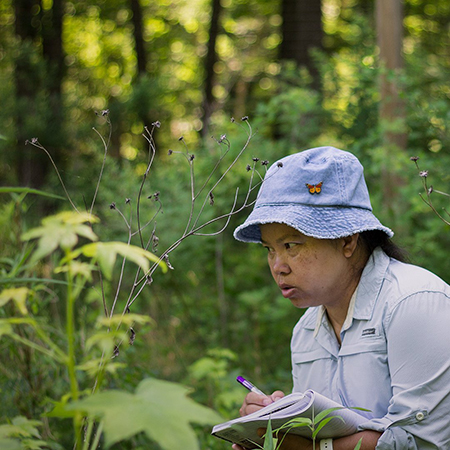HIGHLIGHTS
- Associate Professor of Biology Kunsiri Grubbs has spent part of her summer at the Anne Springs Close Greenway and several other York County locations, combing through areas and searching for this particular sunflower.
- According to the South Carolina Wildlife Federation, the Schweinitz’s sunflower has been on the U.S. Fish and Wildlife Service’s federally endangered list since 1991.

Kunsiri Grubbs at the Greenway
ROCK HILL, SOUTH CAROLINA – A Winthrop University faculty member and some of her students are doing their part to preserve and restore one of the rarest species in the nation: the Schweinitz’s sunflower.
Associate Professor of Biology Kunsiri Grubbs has spent part of her summer at the Anne Springs Close Greenway and several other York County locations, combing through areas and searching for this particular sunflower. The Greenway site, in particular, has a protective fence around the Schweinitz's sunflower population; however, some are found in the prairie-like field, so they are safe from humans, but not from animal browsing.
“The plants tend to grow underneath power lines and along roadsides,” Grubbs explained. “We want to better understand how to help preserve this species. This species is endemic to the Piedmont region and prefers to grow in open and disturbed fields. As new development and construction continues to grow, the habitat for this species becomes harder to find.”
Grubbs noted that much of the previous work on this topic is quite dated.
About the Schweinitz’s sunflower
According to the South Carolina Wildlife Federation, the Schweinitz’s sunflower has been on the U.S. Fish and Wildlife Service’s federally endangered list since 1991. Found only in the Carolinas’ lower Piedmont region – which spans York and Lancaster counties in South Carolina and 10 North Carolina counties – only about 90 known populations exist, a small fraction of which are actually protected.
The species blooms from August to frost and typically grows 3-6 feet tall. The main difference people notice between the Schweinitz’s sunflower and other sunflowers is its tall stature, although its actual head is much smaller than other species.
About the research
Grubbs and two undergraduate students (Thomas Harder and Zachary Taylor) have been researching several aspects on how to support the efforts of the aforementioned Greenway, the S.C. Department of Natural Resources, the Piedmont chapter of the S.C. Native Plant Society and other groups to preserve and restore native plants, including the Schweinitz’s sunflower. Her research has been funded by the South Carolina IDeA Networks of Biomedical Research Excellence (SC INBRE).
The late Richard “Dick” Houk, professor emeritus of biology, had spent nearly three decades studying and saving the Schweinitz’s sunflower. Grubbs had studied the sunflower family before she joined the Winthrop community.
“When I came to Winthrop,” Grubbs said, “Dick spent a lot of time with me to help me get adjusted to the plants in this region. It was a natural fit for me to continue his work on this species.”
Harder, an environmental science major from Anderson, said working on this project has taught him how to identify several new plant species and how to perform DNA extraction and sequencing.
“I want to help protect the environment after I graduate, and I knew I would gain valuable field and lab experience with this research opportunity,” he said.
Taylor, a biology education major from Fort Mill, has similar interests in environmental conservation.
“I’ve grown a love for botany through taking Dr. Grubbs’ courses,” he said. “One thing that’s surprised me about this research is the large variety of sunflowers that are actually in the wild.”
For more information, contact Grubbs at 803/323-2111 or e-mail grubbsk@winthrop.edu.
Original source can be found here.

 Alerts Sign-up
Alerts Sign-up